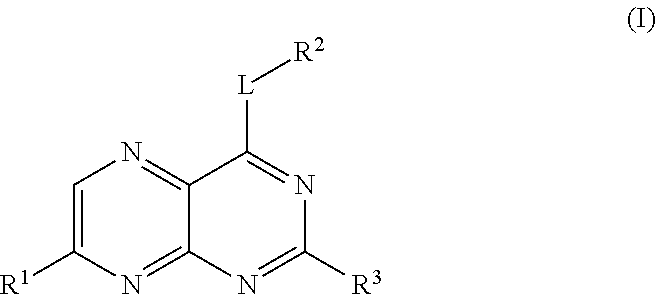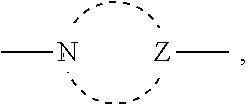Pteridines Useful As HCV Inhibitors And Methods For The Preparation Thereof
a technology of pteridine and hcv, which is applied in the direction of biocide, heterocyclic compound active ingredients, drug compositions, etc., can solve the problems of persistent infection, high rate of chronic infection, and existing infections that continue to present serious medical and economic burden, and achieve the effect of reducing the viral load of patients
- Summary
- Abstract
- Description
- Claims
- Application Information
AI Technical Summary
Benefits of technology
Problems solved by technology
Method used
Image
Examples
example 1
Synthesis of 2-(5-bromo-2-fluorophenyl)-4-(4-pyridylamino)pteridine, Compound No. 1
[0166]
3-(5-bromo-2-fluorobenzoylamino)pyrazine-2-carboxylic acid methyl ester 102
[0167]Pyridine (7.75 g, 98.0 mmol) was added at C under N2 to a solution of 3-amino-pyrazine-2-carboxylic acid methyl ester 101 (1.5 g, 9.80 mmol) and 5-bromo-2-fluorobenzoylchloride (9.45 g, 49.0 mmol) in CH2Cl2. The reaction mixture was warmed at 40° C. for 4 h, then cooled down at room temperature. The reaction mixture was quenched with 20 mL of ethanol, evaporated, partitioned between CH2Cl2 and 1N NaHCO3, dried (Na2SO4) and evaporated. The crude material was triturated in EtOH, filtered, washed with EtOH and ether to give 2.6 g of 3-(5-bromo-2-fluorobenzoyl-amino)pyrazine-2-carboxylic acid methyl ester 102 as a white powder (LCMS analysis).
3-(5-bromo-2-fluorobenzoylamino)pyrazine-2-carboxamide 103
[0168]A mixture of 3-(5-bromo-2-fluorobenzoylamino)pyrazine-2-carboxylic acid methyl ester 102 (2.6 g, 7.34 mmol) and NH4O...
example 2
Synthesis of 4-[[2-(5-Bromo-2-fluorophenyl)pteridin-4-yl]amino]nicotinic acid, Compound No. 16, and 4-[[2-(5-bromo-2-fluorophenyl)pteridin-4-yl]amino]-N-[3-(2-oxopyrrolidin-1-yl)propyl]nicotinamide, Compound No. 21
[0171]
2-(5-Bromo-2-fluorophenyl)-4-Chloropteridine 106
[0172]Thionyl chloride (371 mg, 3.11 mmol) was added to the stirred suspension of 2-(5-bromo-2-fluorophenyl)pteridin-4-one 104 (200 mg, 0.623 mmol) in chloroform (5 mL) and dry DMF (100 μL). The reaction mixture was refluxed under nitrogen for 1 h (starting material gone by HPLC). The solvent was removed in vacuo. Then the residue was triturated in Et2O and filtered off to give 210 mg of the title product 106 as a yellow solid (LCMS analysis).
4-[[2-(5-Bromo-2-fluorophenyl)pteridin-4-yl]amino]nicotinic acid methyl ester 107
[0173]To a solution of 2-(5-bromo-2-fluorophenyl)-4-chloropteridine 106 (200 mg, 0.589 mmol), 4-aminonicotinic acid methyl ester (224 mg, 1.47 mmol) in dichloroethane (5 mL), was added dropwise triethy...
example 3
Synthesis of 2-(5-Bromo-2-pyrrolidin-1-ylphenyl)-4-(3-methyl-4-pyridylamino)pteridine, Compound No. 6
[0176]
2-(5-Bromo-2-pyrrolidin-1-ylphenyl)pteridin-4-one 110
[0177]A solution of 2-(5-bromo-2-fluorophenyl)pteridin-4-one 104 in pyrrolidine was heated in a microwave cavity (Power=270 W, Temp=110° C.) for 12 min. The pyrrolidine was evaporated, then residue partitioned between NaHCO3 0.5 N and CH2Cl2, dried (Na2SO4) and evaporated. Trituration in Et2O afforded the title product 110 as a yellow powder (LCMS analysis).
2-(5-Bromo-2-pyrrolidin-1-ylphenyl)-4-(3-methyl-4-pyridylamino)pteridine 6
[0178]The title product was synthesized by reaction of the 2-(5-bromo-2-pyrrolidin-1-yl-phenyl)pteridin-4-one 110 and 4-amino-3-methylpyridine following the procedure described for 4-(4-pyridylamino)-2-(5-bromo-2-fluorophenyl)pteridine 1 (LCMS analysis).
PUM
 Login to View More
Login to View More Abstract
Description
Claims
Application Information
 Login to View More
Login to View More - R&D
- Intellectual Property
- Life Sciences
- Materials
- Tech Scout
- Unparalleled Data Quality
- Higher Quality Content
- 60% Fewer Hallucinations
Browse by: Latest US Patents, China's latest patents, Technical Efficacy Thesaurus, Application Domain, Technology Topic, Popular Technical Reports.
© 2025 PatSnap. All rights reserved.Legal|Privacy policy|Modern Slavery Act Transparency Statement|Sitemap|About US| Contact US: help@patsnap.com



